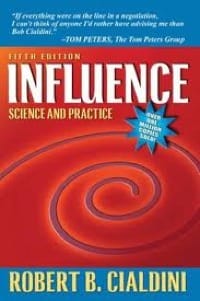New Book Review: "Influence"
New book review for Influence: Science and Practice, by Robert B. Cialdini, Pearson Education, 2009:


The quote by Tom Peters on the cover of the fifth edition is what helped compel me to purchase this text: "If everything were on the line in a negotiation, I can't think of anyone I'd rather have advising me than Bob Cialdini." A colleague of mine noted after the fact that this book recently appeared on a top-20 list of leadership books to read this year, but I have read my share of leadership texts, so what interested me was its apparent focus on negotiation. To some extent, this book is faintly reminiscent of an audio tape called "The Psychology of Selling" by Brian Tracy that a former colleague of mine recommended early in my career, because the focus here is looking at the factors that cause individuals to say "yes", and the techniques that most effectively use these factors to bring about such a decision.
This book is organized around the 6 psychological principles that direct human behavior and give these techniques their power: reciprocation, consistency, social proof, liking, authority, and scarcity. Although this book may have been written to engage the popular reader, the conclusions that the author, a psychology professor at Arizona State University, reaches are based on controlled, psychological research. As Cialdini entertainingly walks the reader through what he learned during his 3-year period of participant observation that served as input to this book, in my opinion although he is both successful at instruction as well as keeping the reader engaged, as with many texts the reader will need to extrapolate in order to apply personally, especially if what is sought is application to the workplace.
Judging by the location of dog ears that were left behind after my reading of this text, the portions I especially appreciated are the first chapter, "Weapons of Influence", the last chapter, "Instant Influence: Primitive Consent for an Automatic Age", and the many sidebars throughout the body of what the author provides called "Reader's Reports". In fact, it turns out that the author has found that the "Readers's Reports" are one of the most popular aspects among readers, and in my opinion these are similar to the "Letters to the Editor" one might find in a newspaper or magazine: people writing in to the author to share how the principles and techniques that are presented in this text have been encountered in the real world. Fascinating lessons learned rooted in science. Recommended reading.